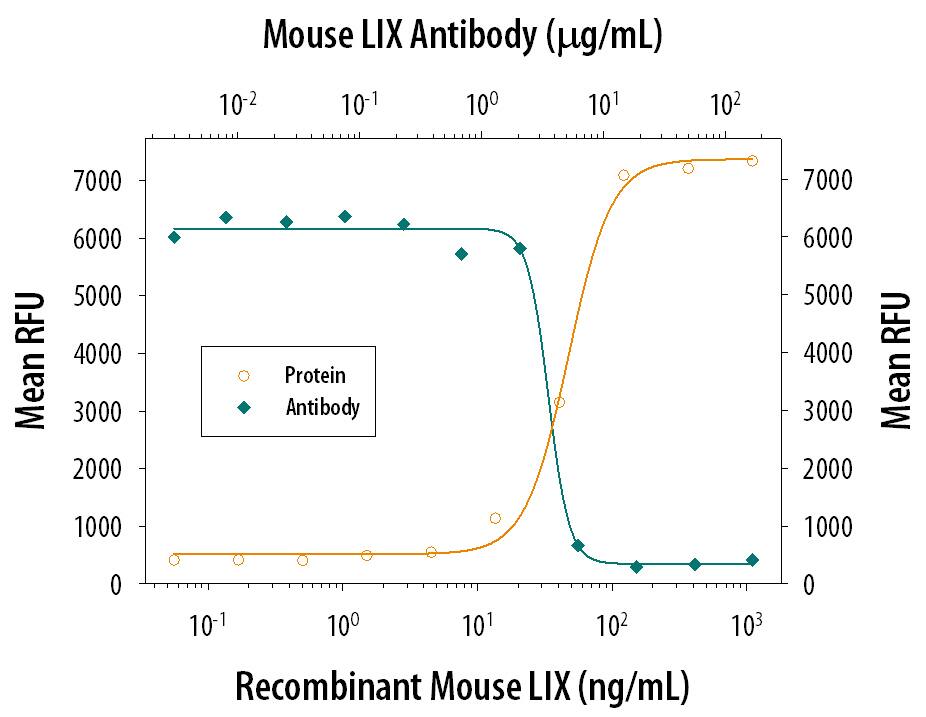Mouse LIX Antibody
R&D Systems, part of Bio-Techne | Catalog # AF433


Key Product Details
Species Reactivity
Validated:
Mouse
Cited:
Human, Mouse
Applications
Validated:
Neutralization, Western Blot
Cited:
Flow Cytometry, Immunohistochemistry-Paraffin, Neutralization, Western Blot
Label
Unconjugated
Antibody Source
Polyclonal Goat IgG
Product Specifications
Immunogen
E. coli-derived recombinant mouse LIX
Val45-Ala118
Accession # P50228
Val45-Ala118
Accession # P50228
Specificity
Detects mouse LIX in direct ELISAs and Western blots. In direct ELISAs, less than 5% cross-reactivity with recombinant human GCP‑2, recombinant rat (rr) CINC‑2 alpha, rrCINC-2 beta, recombinant mouse (rm) KC, and rmMIP‑2 is observed.
Clonality
Polyclonal
Host
Goat
Isotype
IgG
Endotoxin Level
<0.10 EU per 1 μg of the antibody by the LAL method.
Scientific Data Images for Mouse LIX Antibody
Chemotaxis Induced by LIX and Neutralization by Mouse LIX Antibody.
Recombinant Mouse LIX (Catalog # 433-MC) chemo-attracts the BaF3 mouse pro-B cell line transfected with human CXCR2 in a dose-dependent manner (orange line). The amount of cells that migrated through to the lower chemotaxis chamber was measured by Resazurin (Catalog # AR002). Chemotaxis elicited by Recombinant Mouse LIX (0.2 µg/mL) is neutralized (green line) by increasing concen-trations of Goat Anti-Mouse LIX Antigen Affinity-purified Poly-clonal Antibody (Catalog # AF433). The ND50 is typically 1-5 µg/mL.Applications for Mouse LIX Antibody
Application
Recommended Usage
Western Blot
0.1 µg/mL
Sample: Recombinant Mouse LIX (Catalog # 433-MC)
Sample: Recombinant Mouse LIX (Catalog # 433-MC)
Neutralization
Measured by its ability to neutralize LIX-induced chemotaxis in the BaF3 mouse pro‑B cell line transfected with human CXCR2. The Neutralization Dose (ND50) is typically 1-5 µg/mL in the presence of 0.2 µg/mL Recombinant Mouse LIX.
Formulation, Preparation, and Storage
Purification
Antigen Affinity-purified
Reconstitution
Reconstitute at 0.2 mg/mL in sterile PBS. For liquid material, refer to CoA for concentration.
Formulation
Lyophilized from a 0.2 μm filtered solution in PBS with Trehalose. *Small pack size (SP) is supplied either lyophilized or as a 0.2 µm filtered solution in PBS.
Shipping
Lyophilized product is shipped at ambient temperature. Liquid small pack size (-SP) is shipped with polar packs. Upon receipt, store immediately at the temperature recommended below.
Stability & Storage
Use a manual defrost freezer and avoid repeated freeze-thaw cycles.
- 12 months from date of receipt, -20 to -70 °C as supplied.
- 1 month, 2 to 8 °C under sterile conditions after reconstitution.
- 6 months, -20 to -70 °C under sterile conditions after reconstitution.
Background: LIX
Additional LIX Products
Product Documents for Mouse LIX Antibody
Product Specific Notices for Mouse LIX Antibody
For research use only
